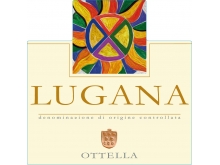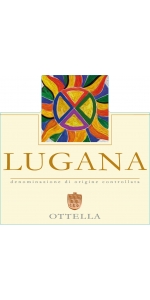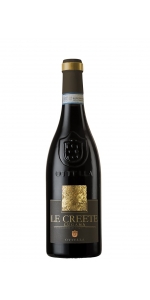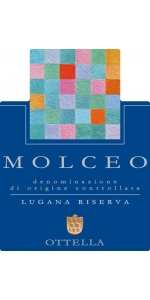Ottella Lugana Bianco 2022 (half bottle)
Ottella Lugana Bianco is a white wine made from 100% Trebbiano di Lugana (same as Verdicchio)
The grapes for this wine come from the estate vineyards in San Benedetto di Lugana - vineyards that are most suitable due to the high content of white clay.
Intense straw yellow color with green tinges. Exotic notes, candied and citrus fruits, fine and elegant minerality. Warm and deep on the nose. Expressive finesse, rich and persistent texture on the palate.
Pairs best with fish-based plates, soup, pasta or rice, white meats.
Ottella Lugana Bianco is produced in South Benedetto di Lugana. 100% Turbiano (clonal type of Trebbiano di Lugana)
The grapes are harvested exclusively from our own vineyards; harvesting is strictly manual in small 17kg-crates. Guyot, double arc training method.
A brief contact on the skin, stainless steel-controlled fermenting.
Intense straw yellow color with green tinges. Exotic notes, candied fruit and citrus, warm and very deep on the nose. Widespread expressive finesse; to the palate the texture is rich and persistant.
Pairs best with fish-based plates, soup, pasta or rice, white meat.
Ottella Lugana Bianco is produced in South Benedetto di Lugana. 100% Turbiano (clonal type of Trebbiano di Lugana)
The grapes are harvested exclusively from our own vineyards; harvesting is strictly manual in small 17kg-crates. Guyot, double arc training method.
A brief contact on the skin, stainless steel-controlled fermenting.
Intense straw yellow color with green tinges. Exotic notes, candied fruit and citrus, warm and very deep on the nose. Widespread expressive finesse; to the palate the texture is rich and persistant.
Pairs best with fish-based plates, soup, pasta or rice, white meat.
Ottella Lugana DOC Le Creete is made from 100% Trebbiano di Lugana (same as Verdicchio)
The grapes for this wine come from the estate vineyards in San Benedetto di Lugana.
Golden, warm, intense straw yellow. Exotic notes of pineapple and grapefruit with delicate minerality.
Finesse yet a strong character. Rich and well balanced, firm, mineral wine with a superb pulp.
Pairs best with sea or lake fish to bring out its outstanding features; goes well with white meat and soup, and has quite a surprising affinity with full-flavored and blue cheeses.
Ottella Lugana DOC Le Creete is made from 100% Turbiano (clonal type of Trebbiano di Lugana)
PRODUCTION AREA: S. Benedetto di Lugana. The grapes are harvested exclusively from our own vineyards; harvesting is strictly manual in small 17kg-crates
TRAINING METHOD: Guyot, double arc
Golden, warm, intense straw yellow. Immediate exotic notes.
It develops in a very pleasant fashion, good mineral impression Rich, succulent and well balanced for a truly
satisfactory mouthfeel. Mineral on the finish with just enough acidity to
provide lift and depth.
FOOD: Sea or lake fish to bring out its outstanding features; goes well with white meat and soup, and has quite a surprising affinity with tasty cheese
ALCOHOL BY VOLUME: 13% vol
SERVING TEMPERATURE: 10-12 degrees Celcius
Ottella Lugana DOC Riserva Molceo is made from 100% Trebbiano di Lugana - 25-30 years old.
The wine is produced in the area of San Benedetto di Lugana in estate vineyards that are most suitable due to the high content of white clay.
COLOR • Golden, clear, intense.
NOSE • It immediately opens with fruity notes that are enchanting, penetrating and complex. Characterized by hints of citrus fruits, flowers and fine mineral and elegant notes.
PALATE • Complex and intense blend of mineral flavors; captivating, long, lively, both in the persistence and in the strength of the flavors, mingling with unmissable citrus sensation. A delicate evolution, fine flesh, perfect longevity.
Since 2009 it has won every year the TRE BICCHIERI GAMBERO ROSSO award.
The harvest and selection of the grapes are done strictly by hand, in small 17 kg crates.
PLANTING LAYOUT AND YIELD • Double bow Guyot, yield around 8,000 kg. of grapes per hectare, equivalent to 5,040 liters of wine or 63%.
HARVEST PERIOD • Harvest late in October.
FINING AND FERMENTATION • Delicate, soft pressing of the whole bunch for most of the production, the rest with gentle destemming by oscillation. Thereafter, a strict protocol of vinification: partial malolactic fermentation, fining for 16 months on the yeast and fine lees, which mostly takes place in stainless steel tanks (80%) and the rest in wooden tonneaux and barriques.
Stimulating with marine or freshwater fish, it also goes well with savory or fatty meat (goose or pork). Enjoyable with seasoned, herbal cheeses of various types and elaborate dishes.
Review:
This riserva Lugana opens with aromas of baked nectarine with an almond crumble, followed by wafting notes of pressed wildflowers and poached lemon peel. The palate is rich, showing a lime and tropical-fruit cream note topped with sea salt, but balanced by the electric acidity on the finish. Super tasty!
-Wine Enthusiast 93 Points
Elegant and delicate in its sensorial profile, it shows notes of rose petals, linden, geraniums, hawthorn and lime. Medium-full body, radiant and essential in taste, it shows grace and personality and a truly Mediterranean aftertasting. Nice and tasty, fresh and vibrant! One of the best Lugana tastings. Drink now or grow old.
-Raffaele Vecchione - WinesCritic.com 94 Points
Produced in South Benedetto di Lugana. 100% Turbiano (clonal type of Trebbiano di Lugana)
The grapes are harvested exclusively from our own vineyards; harvesting is strictly manual in small 17kg-crates. Guyot, double arc training method.
A brief contact on the skin, stainless steel-controlled fermenting.
Intense straw yellow color with green tinges. Exotic notes, candied fruit and citrus, warm and very deep on the nose. Widespread expressive finesse; to the palate the texture is rich and persistant. Pairs best with fish-based plates, soup, pasta or rice, white meat.
The Otella Estate
Azienda Agricola Ottella was founded in 1880 and the Montresor family has been grape growers for many generations at the Southern end of Lake Garda, near Peschiera del Garda in the D.O.C. (northwest Italy).
The winery is named after a legend that says some octuplets were born at the farm in the 16th century, and the family had immortalized the tradition naming the winery "Ottella".
The Otella Vineyard
The family owns 25 hectares (61.75 acres) of vines planted on a very typical clayey soil, and favorably influenced by the proximity of the Lake Garda. The family also owns a small parcel called "Le Creete", planted on a white chalky soil that gives the wine its exceptional character.
- back
Irresistible ripened plums and opulent dusty blackberries lift the senses, alluring the nose to tertiary notes of delicate florals and intriguing mineral edges. Balance is the defining quality of this wine; even in its youth, 2021 Black Label is resolutely complete from beginning to end. Every element is in place, as dimpled yet silky tannins unfold with grace and finesse, revealing a core of power and depth. Broad strokes of black mulberries, crème de cassis, and juniper accelerate through the mid-palate with captivating width and focus. This thrilling dance culminates in a stunning finish of opulent and elegant dark fruits that persist with each sip, leaving an indelible impression of the near-perfect growing season that shaped the Fortuna Vineyard—full of power and sinue—and Leopoldina Vineyard—full of poise and intention—in the 2021 vintage.
"Stunning stuff, the 2021 Cabernet Sauvignon Black Label offers a full-bodied, deep, majestic style as well as beautiful aromatics of cr me de cassis, violets, flowers, and nicely integrated background oak. It has ultra-fine tannins, flawless balance, and a regal, age-worthy style that has so much to love. It, however, is not going to be for the instant gratification crowd and this actually shut down pretty quickly with air. I would hide bottle for 4-6 years and it s going to cruise over the following two decades in cold cellars."
- 97 Points Jeb Dunnuck
Siegel Naranjo Orange Wine Viognier is made from 100% Viognier.
This wine has a nice gold color with some pink hues. On the nose, it shows some sweet notes of spices, dry nuts, white flowers, as well as some light notes of huesillo (dry peaches). In the mouth it shows a beautiful acidity, with a nice mouthfeel and structure and a good length to the finish.
Pair with rich fish and meat dishes, cheeses, appetizer and dessert.








